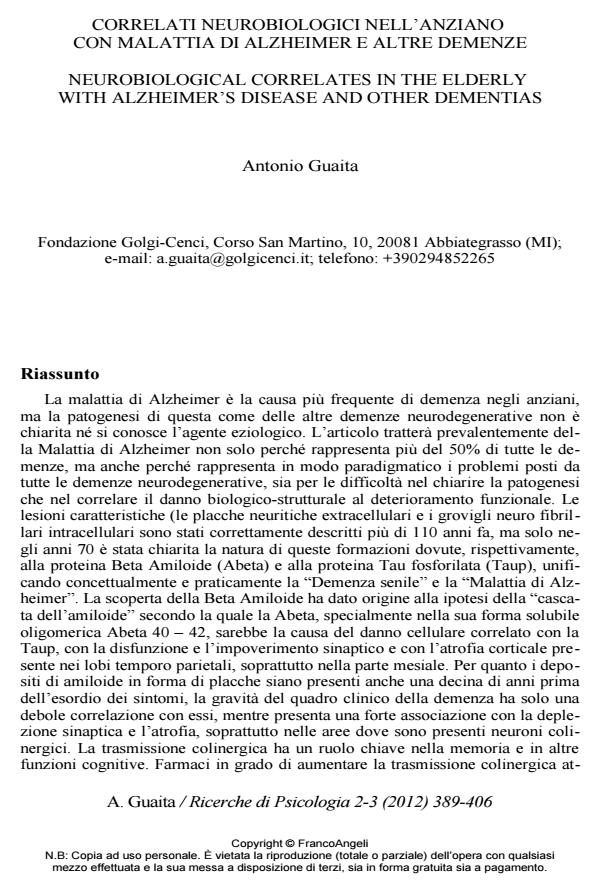Neurobiological correlates in the elderly with alzheimer’s disease and other dementias
Journal title RICERCHE DI PSICOLOGIA
Author/s Antonio Guaita
Publishing Year 2013 Issue 2012/2-3
Language Italian Pages 18 P. 389-406 File size 224 KB
DOI 10.3280/RIP2012-002016
DOI is like a bar code for intellectual property: to have more infomation
click here
Below, you can see the article first page
If you want to buy this article in PDF format, you can do it, following the instructions to buy download credits

FrancoAngeli is member of Publishers International Linking Association, Inc (PILA), a not-for-profit association which run the CrossRef service enabling links to and from online scholarly content.
Alzheimer’s disease (AD) is a major cause of dementia in the elderly. The causative agent for any of the neurodegenerative dementias has not been cleared until today and is completely open the discussion about different pathogenetic hypotheses . This article is focused on Alzheimer’s disease not only because it is the prevalent cause of dementia (more than 50%), but also because it represents a paradigm of the problems posed by all neurodegenerative dementias, both in clarifying pathogenesis and in correlating biological-structural damage to functional deterioration. The characteristic lesions (extracellular neuritic plaques and intracellular neurofibrillary tangles) were correctly described more than 110 years ago, but only in the 70’s was clarified the nature of these formations, respectively due to the protein Amyloid Beta and Tau protein phosphorylated by unifying senile dementia and Alzheimer’ disease. The discovery of Beta Amyloid gave rise to the pathogenetic hypothesis of "amyloid cascade". Amyloid protein, mainly soluble oligomeric Abeta40-42, would be the source of the cell damage, producing neurofibrillary tangles of Tau protein, synaptic dysfunction and cortical atrophy in the temporo-parietal areas, especially the mesial temporal area, where it takes place early atrophy. As the Amyloid deposits are considered to be present more than a decade before symptoms, however the clinical severity of dementia has only a weak correlation with the presence of neuritic plaques, while it strongly correlates with the synaptic depletion and cortical atrophy, especially in the areas where cholinergic neurons are present. Cholinergic transmission has a key role in memory and other cognitive functions and drugs able to increase cholinergic transmission through the inhibition of acetylcholinesterase are currently in use as a symptomatic treatment of cognitive deficits. The Neurotoxicity is now mainly ascribed to the soluble forms of Beta Amyloid, while the plaques could also be in- terpreted as a consequence, in some way a possible mechanism of inactivation and defense against the oligomeric toxicity. The cerebral vascular damage may in itself cause dementia, but also has an important role in Alzheimer’s disease, where the vascular damages of various degrees are always present, so that the two entities are often not distinguishable. Other types of dementia are associated with Frontotemporal Lobar degeneration or with the deposition of Lewy body, but with advancing age the neuropathological findings overlap very frequently. Other types of dementia are associated with Frontotemporal Lobar degeneration or with the deposition of Lewy body, but with advancing age the neuropathological findings overlap very frequently also in the brain of persons free of dementias. This raises problems for the definition of the neurobiological findings of degenerative dementias that are not only technical but also conceptual in nature and epistemological.
Keywords: Dementia, Alzheimer’s disease, neuropathology, beta amyloid, biological markers.
Antonio Guaita, Correlati neurobiologici nell’anziano con malattia di alzheimer e altre demenze in "RICERCHE DI PSICOLOGIA " 2-3/2012, pp 389-406, DOI: 10.3280/RIP2012-002016